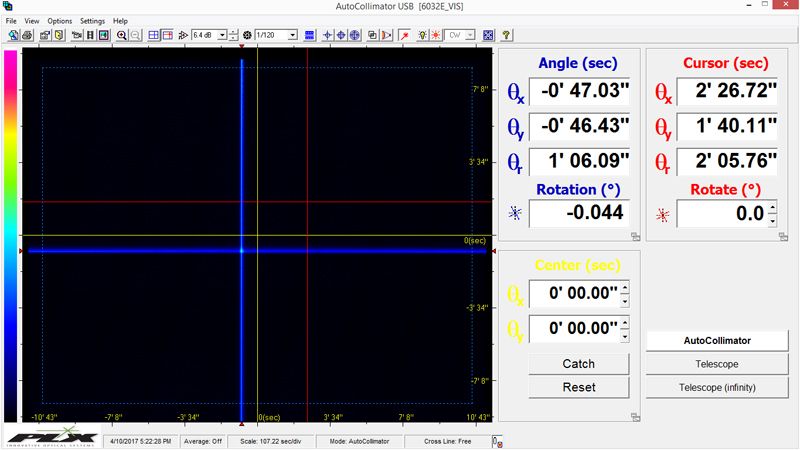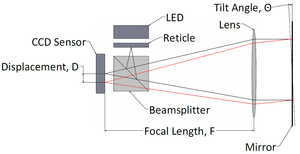
Software
The software automatically displays angle deviation and can give the relative position of multiple targets.
Data logging is supported and can be configured to record for a predetermined time or a fixed number of data points. The recording interval can also be set. The data can be saved to a file or streamed to a remote location via RS-232 or TCP/IP. The communication setting for both RS-232 and TCP/IP is fully configurable from the software.

Besides taking interval measurements, the software supports video recording of the screen image for later playback and analysis.
Another analysis tool is the ability save images and then to tile multiple saved images and view them simultaneously.
To account for different measuring conditions the software can average measurements or merge them. Average will reduce the fluctuations in the reading in cases where there is a slight jitter or vibration in the object being measured. Merge integrates several (2 to 10) measurements to account for low light levels.
All measurements and displays can be saved and printed for later study and analysis.
Exposure via gain and shutter speed can be set automatically or adjusted manually if necessary. In conjunction with a special tracking target, the software will automatically find the center of the target as the target is moved through the field of view. This is useful for measuring straightness of travel of translation stages and machine beds.
Accessories
Accessories for the ACT-25 include Hollow Retroreflectors, Lateral Transfer Hollow Retroreflectors (LTHRTM), Lateral Transfer Hollow Periscopes (LTHPTM), Tool Cube TM and cooperative target .
LTHRs and Periscopes are used to offset the beam of the autocollimator, while maintaining parallelism to the original beam direction, allowing you to create a second optical axis. You'll find this useful in boresighting and other multi-axis alignment situations. The Periscope offsets the beam while keeping it going in the same direction while the LTHR offsets the beam and changes the direction 180°. Both the Periscope and LTHR can be equipped with a beamsplitter to provide two parallel beams at the same time.
The state-of-the-art retroreflector is useful for setting the infinity focus of the autocollimator and verifying its performance.
The cooperative target is recognized by the ACT-25 software, which automatically finds the center of the target.
Applications
Overview
The Electronic Autocollimator/Alignment Telescope is a precision optical device, and it has two distinct modes of operation. The basic difference between the two modes is that the autocollimator measures tilt or rotation of the object while the alignment telescope measures lateral displacement. Also, lateral displacement can be given as either a linear value or an angular displacement, depending on the set-up. Certain applications may require that both modes are employed.
As an autocollimator, the unit projects a crosshair pattern out to the object being monitored. The object needs to be either highly reflective or have a mirror attached to it. The cross hair is reflected back to the autocollimator and the degree of tilt of the object is measured. You do not see the actual object, just the reflection of the cross hairs.
The second mode is as an alignment telescope. Here there are two op tions, they are labeled Telescope and Telescope (infinity). A Telescope option is used with a Cooperative Target. The software recognizes the target geometry and tracks the center of the target. In this mode it is necessary to know the distance between the target and the alignment telescope. With this application the display gives the linear displacement of the target.
tions, they are labeled Telescope and Telescope (infinity). A Telescope option is used with a Cooperative Target. The software recognizes the target geometry and tracks the center of the target. In this mode it is necessary to know the distance between the target and the alignment telescope. With this application the display gives the linear displacement of the target.
Boresighting
Boresighting is the aligning of a targeting system or systems with the barrel of a weapon, or the co-alignment of different targeting systems (visible and infrared). Boresighting will typically require some additional set-up/equipment. This could take the form of an accurate translation stage or an LTHR or periscope possibly equipped with a beam splitter.
The set-up here is highly dependent on the configuration and number of objects being bore-sighted.